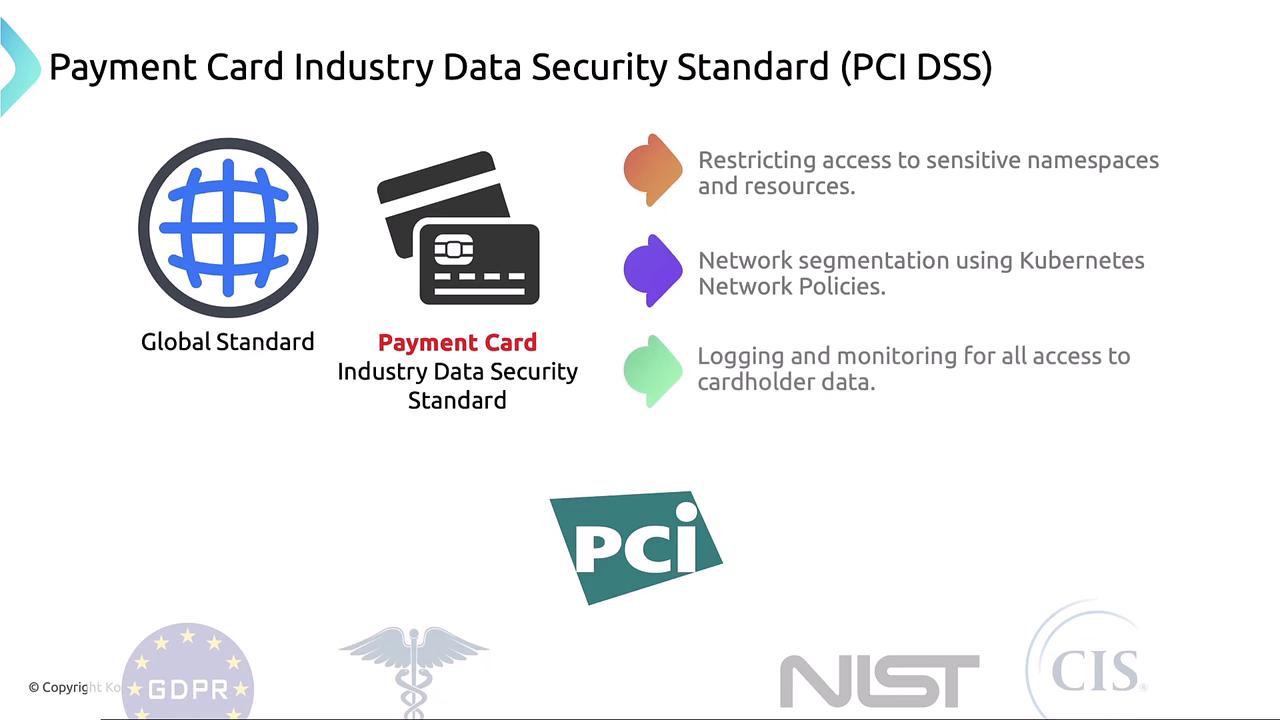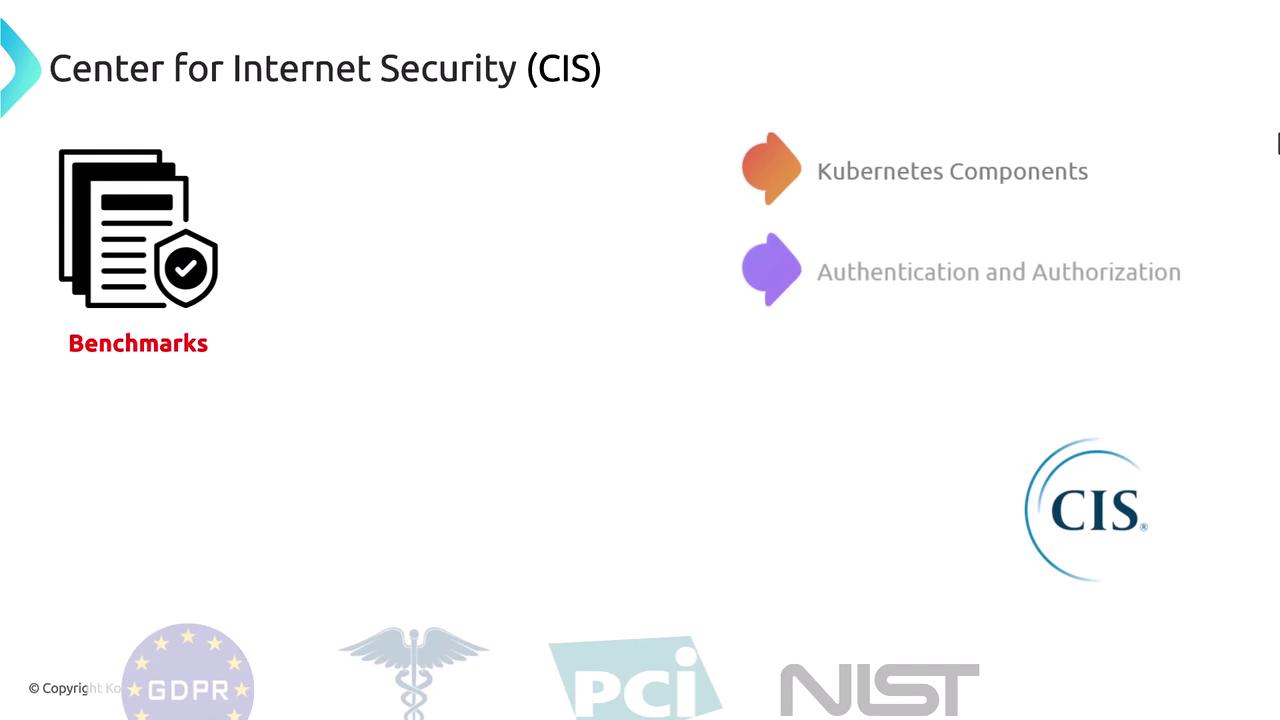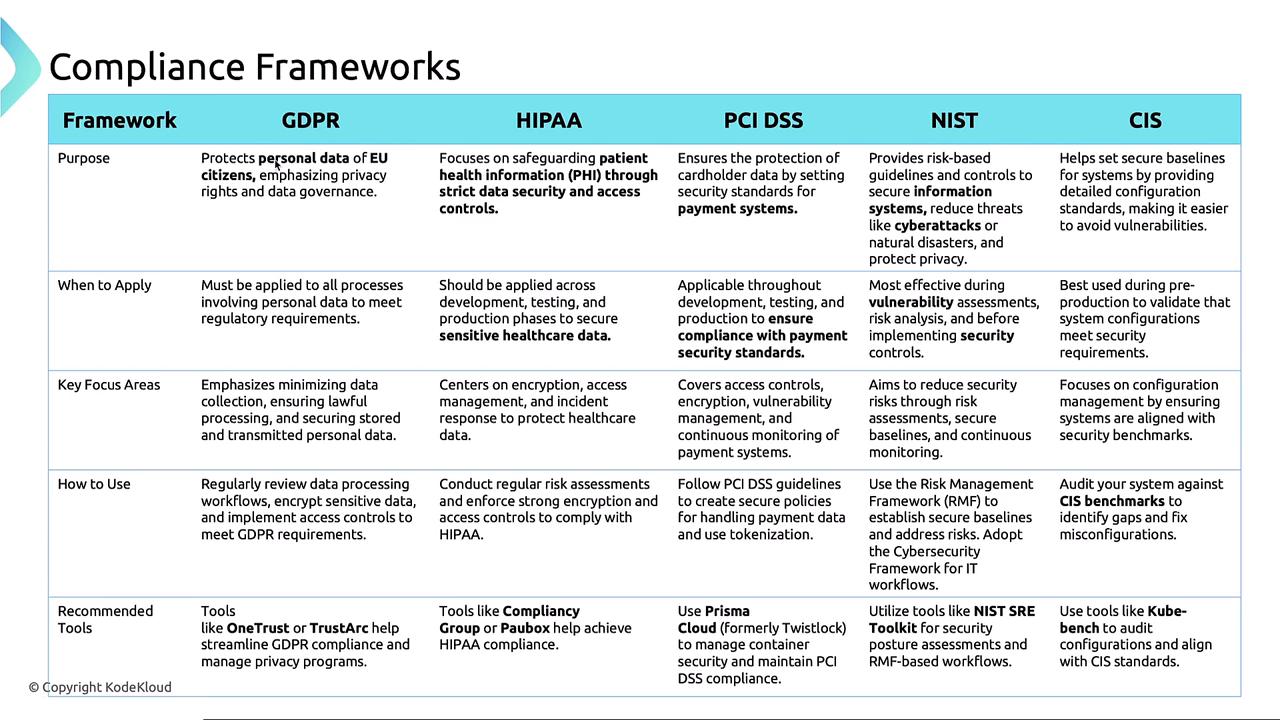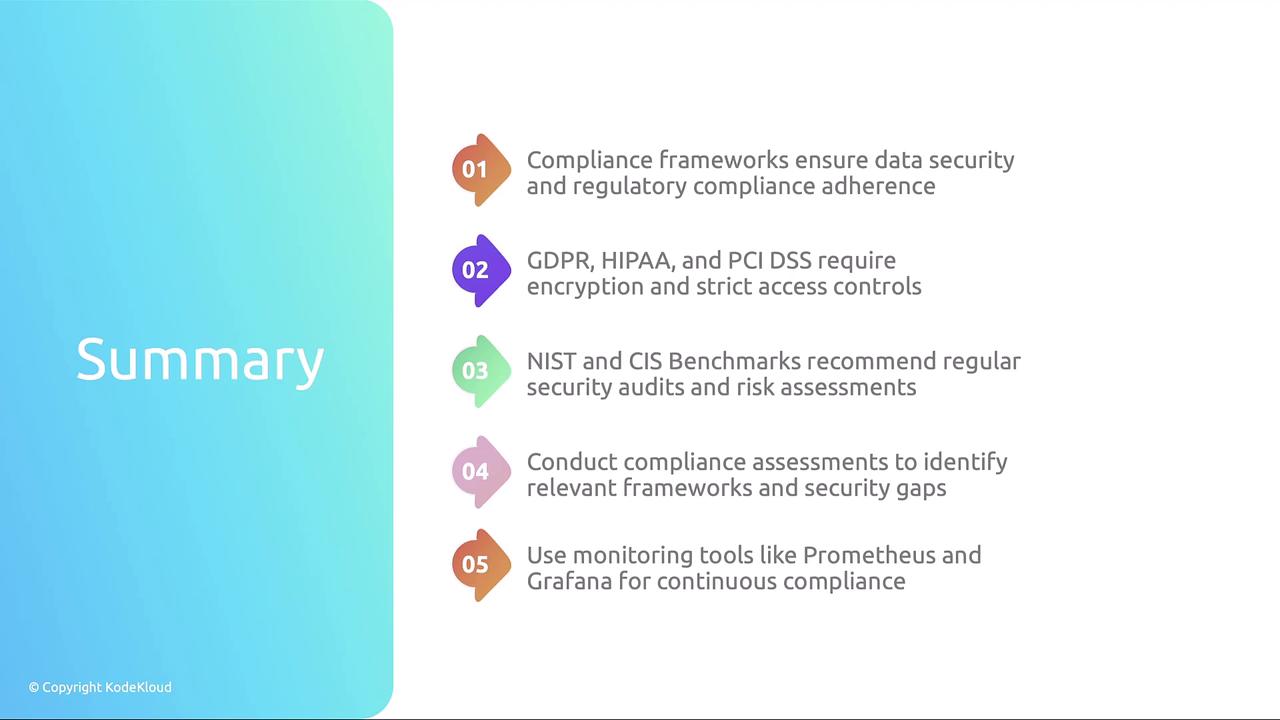Kubernetes and Cloud Native Security Associate (KCSA)
Compliance and Security Frameworks
Compliance Frameworks
Security compliance frameworks are essential for safeguarding sensitive data—personal information, health records, payment details—and ensuring system integrity and legal compliance. Ignoring these guidelines can lead to data breaches, hefty fines, and loss of customer trust. In this lesson, we’ll explore the major frameworks and how they apply to Kubernetes environments.
Warning
Non-compliance can result in severe penalties, data exposure, and reputational damage.
To begin, here’s a high-level comparison of the frameworks we’ll cover:
| Framework | Scope | Key Requirements |
|---|---|---|
| GDPR | EU personal data protection | Encrypt data at rest, restrict data access |
| HIPAA | US healthcare PHI | TLS encryption, strict access controls, secure secrets |
| PCI DSS | Payment card data | Encrypt in transit & at rest, auditing, strong auth |
| NIST | Cybersecurity best practices | Risk assessments, security controls, periodic audits |
| CIS Benchmarks | IT system hardening | Secure configs, RBAC, network policies, logging |
GDPR (General Data Protection Regulation)
The GDPR is an EU regulation that protects individuals’ personal data and privacy rights. In a web application context, GDPR compliance often includes:
- Encrypting user data stored in your MySQL database (data at rest)
- Ensuring only authorized back-end services can access personal data
![]()
HIPAA (Health Insurance Portability and Accountability Act)
HIPAA is a U.S. regulation focused on protecting sensitive patient health information (PHI). For applications handling patient data, you must:
- Encrypt all data transfers (front-end ↔ back-end ↔ database) using TLS
- Implement strict access controls to prevent unauthorized access
- Securely configure Kubernetes Secrets for application use
Note
Ensure your TLS certificates are managed via a secure certificate authority and rotated regularly.
PCI DSS (Payment Card Industry Data Security Standard)
The PCI DSS applies to any system processing payment card data. Key requirements include:
- Encrypting cardholder data in transit and at rest
- Enforcing strong access controls
- Monitoring and auditing all access to payment information

NIST (National Institute of Standards and Technology)
NIST publishes the Cybersecurity Framework to improve the security and resilience of information systems. For web applications, typical NIST controls involve:
- Conducting regular risk assessments to identify vulnerabilities
- Implementing security controls (firewalls, IDS/IPS)
- Performing periodic security audits
![]()
CIS Benchmarks (Center for Internet Security)
CIS provides detailed benchmarks for securing IT systems, including Kubernetes. These guidelines cover:
- Secure configuration of control plane components (API server, etcd, kubelet, controller-manager, scheduler)
- Authentication and authorization (enforce RBAC, disable anonymous access)
- Logging, monitoring, network policies, and pod security
Tools like Aqua Security’s kube-bench automate verification of these benchmarks. Below is a sample output from running kube-bench against a Kubernetes cluster:
[INFO] 1.1 API Server
[FAIL] 1.1.1 Ensure that the --allow-privileged argument is set to false (Scored)
[FAIL] 1.1.2 Ensure that the --anonymous-auth argument is set to false (Scored)
[PASS] 1.1.3 Ensure that the --basic-auth-file argument is not set (Scored)
[FAIL] 1.1.4 Ensure that the --insecure-allow-any-token argument is not set (Scored)
[FAIL] 1.1.5 Ensure that the --kubelet-https argument is set to true (Scored)
[FAIL] 1.1.6 Ensure that the --insecure-bind-address argument is not set (Scored)
[FAIL] 1.1.7 Ensure that the --secure-port argument is not set to 0 (Scored)
[FAIL] 1.1.8 Ensure that the --profiling argument is set to false (Scored)
[PASS] 1.1.9 Ensure that the --repair-malformed-updates argument is set to AlwaysAdmit (Scored)
[PASS] 1.1.10 Ensure that the admission control policy is set to AlwaysPullImages (Scored)
[PASS] 1.1.11 Ensure that the admission control policy is set to DenyEscalatingExec (Scored)
[PASS] 1.1.12 Ensure that the admission control policy is set to SecurityContextDeny (Scored)
[PASS] 1.1.13 Ensure that the admission control policy is set to NamespaceLifecycle (Scored)
[FAIL] 1.1.14 Ensure that the --audit-log-path argument is set as appropriate (Scored)
[FAIL] 1.1.15 Ensure that the --audit-log-maxage argument is set to 30 or as appropriate (Scored)
[FAIL] 1.1.16 Ensure that the --audit-log-maxbackup argument is set to 10 or as appropriate (Scored)
[FAIL] 1.1.17 Ensure that the --audit-log-maxsize argument is set to 100 or as appropriate (Scored)
[FAIL] 1.1.18 Ensure that the --authorization-mode argument is not set to AlwaysAllow (Scored)
[FAIL] 1.1.20 Ensure that the --token-auth-file parameter is not set (Scored)
[FAIL] 1.1.22 Ensure that the --kubelet-certificate-authority argument is set as appropriate (Scored)

Below is a visual comparison of these frameworks—when they apply, their focus areas, and recommended tools:


Key takeaways:
- Compliance frameworks guide data protection, encryption, and access controls
- GDPR targets personal data of EU citizens
- HIPAA safeguards protected health information (PHI)
- PCI DSS secures payment card data
- NIST offers risk assessment and security control guidelines
- CIS Benchmarks provide granular, automated checks for Kubernetes security
Links and References
- GDPR (General Data Protection Regulation)
- HIPAA (Health Insurance Portability and Accountability Act)
- PCI DSS (Payment Card Industry Data Security Standard)
- NIST Cybersecurity Framework
- CIS Benchmarks
Watch Video
Watch video content